Skin Breathing
If you saw the film Goldfinger, you will remember the scene where James Bond was knocked out and woke up to find Jill Masterson (Shirley Eaton) dead after being covered in gold paint – supposedly, death by skin asphyxiation.
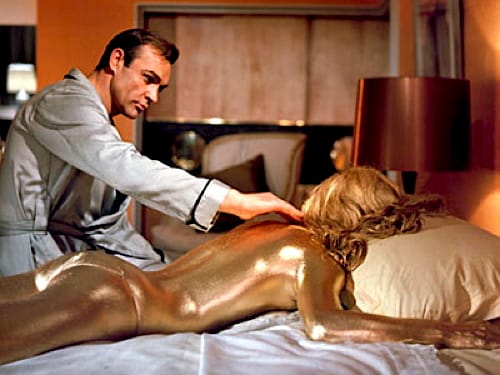
Death supposedly by skin asphyxiation in the James Bond film ‘Goldfinger’ (Universal Studios, 1964).
The erroneous idea that the skin ‘breathes’ – and can therefore be suffocated – was not confined to the 1960s. It thrives on the Internet to this day, most commonly on websites that proclaim the benefits of natural skin-care and/or provide dubious lists of harmful additives to be found in skin and hair-care products. The substance most frequently said to ‘suffocate the skin’ is mineral oil. The extracts below are typical:
Extract 1
A derivative of crude oil (petroleum) that is used industrially as a cutting fluid and lubricating oil. Mineral oil forms an oily film over the skin to lock in moisture, toxins and wastes, but hinders normal skin respiration by keeping oxygen out.Extract 2
It [mineral oil] comes from crude oil (petroleum) that is used in industry as metal cutting fluid. It may suffocate the skin by forming an oil film. Healthy skin needs oxygen, and it needs to release carbon dioxide. It should not be inhibited.Extract 3
Petroleum-based [mineral oil] standard chemical skincare further causes problem by blocking skin respiration to suffocate skin.
These statements infer that skin gets substantial amounts of the oxygen directly from the air and that cutting it off from this source reduces oxygen absorption, impedes respiration and adversely affects skin function. This is a very old idea based on some fundamental misconceptions on the functions of the skin’s pores.
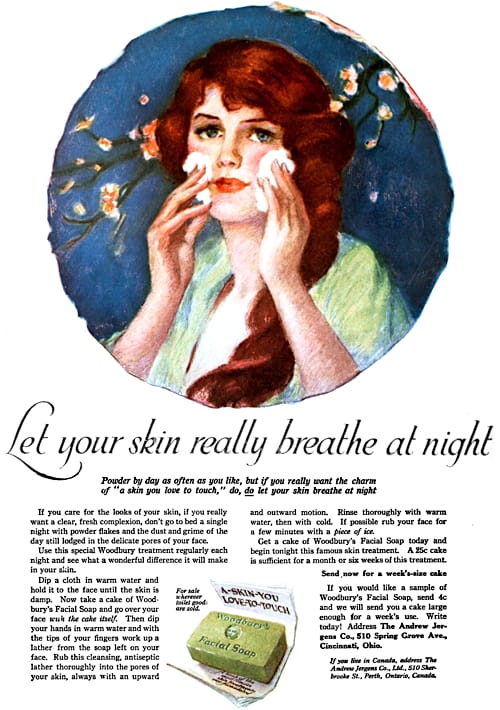
Above: 1917 Woodbury Facial Soap to cleanse the pores and allow skin breathing.
The barrier function of the skin
One of the primary functions of the skin is to act as a barrier. Harmful microbes and chemicals are kept out and water is kept in so if this barrier is compromised our life is put at risk. For example, patients with severe burns, who survive the shock and trauma, frequently die from dehydration or infection due to the barrier function of the skin being compromised.
What often misleads people is that the skin has pores. Even if we do not see them in the mirror, the beauty industry reminds us they are there and tries to sell us cosmetics to reduce their appearance. However, pores do not mean that the skin itself is very porous; their function is to allow the skin to release substances on to the skin surface, not to act as a passage for substances coming in through the barrier.
Also see: Enlarged Pores
Again cosmetic advertising is partially at fault here. If we are to accept that ingredients in an expensive skin cream are going to be effective, then we need to believe that they can be absorbed into the skin and affect the functioning of living skin cells. However, if an ingredient was able to do this, the skin cream would be classified as a drug not a cosmetic.
Also see: What is a Cosmetic?
Intact skin is not totally impervious to all substances. Some chemicals can penetrate the skin barrier, e.g., nicotine in nicotine skin patches. Conversely, some materials can restrict the flow of materials in the other direction, e.g., moisturisers may reduce moisture loss. However, if the skin is to function as an effective barrier against dehydration then it needs to be dry and a dry surface is not good at absorbing oxygen.
Gas exchange
Oxygen is not very soluble in water and it requires more than a few bodily tricks to get sufficient oxygen into the blood to service our needs. In order for a surface to be able to exchange oxygen and carbon dioxide it needs three characteristics: it must be thin, moist, and have a large surface area. All of these characteristics are found in the lungs. The alveoli in the lungs that conduct gas exchange are very thin, are kept moist and have an extensive blood supply to carry oxygen away to the rest of the body and bring the carbon dioxide waste to it. The membranes are also very delicate which is why our lungs are inside the body – they are there because they need protecting.
Being relatively thick and dry, the skin is not good at absorbing oxygen. Fortunately, living skin cells do not get their oxygen directly from the air but indirectly from the lungs through the blood supply. So, cleansing the skin, using an ‘oxygenated’ skin cream, or spraying the skin with oxygen will not increase the supply of oxygen to the skin.
Painting the skin, as in the James Bond movie, will also have little or no effect on the skin’s oxygen supply. This does not meant that it is not dangerous. If the paint restricts perspiration the body may be affected by heat stress.
Cellular respiration, the skin, and ageing
In 1937, Hans Adolf Krebs published his work on the tricarboxylic acid (TCA) cycle and opened up the biochemical pathways associated with cellular respiration. The skin, like all body tissues, gets its energy from cellular respiration and scientists interested in the functioning of the skin began to examine its effects.
Some scientists studying skin claimed that the level of cellular respiration was higher in younger than in older skin. This led to speculation that if skin respiration could be increased then perhaps skin ageing could be reversed. Given this idea, we can see why fads such as adding ‘oxygen releasing’ chemicals to skin care products, or applying cosmetic products in combination with oxygen might get some traction.

Above: 1956 Oxygen Therapy (France). The session under the tent generally lasted from 20 to 30 minutes. As shown here, an ultraviolet treatment of one or two minutes could be done at the same time, during which the eyes were covered with black glasses.
Extract 1
There are many ways for the oxygen to be administered. Dry oxygen gas may be used to send nutrient based oils onto the skin, liquid oxygen mixed with other oils can be misted onto the skin, and there are oxygen based facial creams or serums available. Oxygen facials may incorporate the use of various hydrogen peroxide creams. These are believed to help oxygen and water to permeate the skin. In each process, the oxygen is seeping into the skin, allowing the nourishment and revitalization of skin cells. In essence, the oxygen is improving your skin from the inside out.
Extract 2
Specially developed cosmetic products are sprayed onto the skin with pure oxygen. A gentle treatment ideal after cosmetic procedures, intensive-peeling treatments, for impure skin, for sunburnt skin or simply for a relaxing oxygen massage.
Extract 3
The application of oxygen under hyperbaric pressure allows the epidermis to maximise its oxygen surface level concentration. This pressure also assists in the rapid absorption of the intraceuticals serum that is enriched with Hyaluronic Acid (the skin’s natural moisturiser) Vitamins A, C and E as well as Green Tea extract and Aloe Vera. The results you see when you leave the clinic are visible and lasting. The gentle process is non-invasive, painless, and safe both during and after the treatment.
Of course, surrounding the body with oxygen is not going to markedly increase the supply of oxygen to the living skin cells. Besides, as we now know, oxygen has a darker side.
Oxidative stress
The discovery that free radicals are by-products of cellular respiration put a dent in the marketing idea that increasing oxygen will counteract skin ageing. The body continuously produces harmful oxidants – such as superoxide and hydrogen peroxide – from internal sources such as mitochondrial respiration, and it can also pick them up from exposure to environmental agents such as smog, cigarette smoke, and UV radiation. The body has a system of antioxidants to mop up these free radicals but, if placed under oxidative stress, elevated levels of free radicals may result producing an increased risk of diseases such as cancer. So, even if by some chance it was possible to increase oxygen absorption through the skin, this might be a bad, rather than a good thing.
Free radicals were something that cosmetic manufacturers could get their teeth into and antioxidants such as vitamins A, E and C have been in cosmetics for a long time.
Also see: Vitamin Creams
Some cosmetic manufacturers have suggested that the antioxidants in cosmetics could penetrate the skin, thereby reducing the signs of skin damage and ageing caused by oxidation. However, although there is evidence that some absorption of vitamins in skin creams does take place, it would be cheaper, and more effective, simply to get these vitamins in your diet.
First Posted: 4th May 2009
Last Update: 1st April 2025
Sources
Sagarin, E. (Ed.). (1957). Cosmetics: Science and technology. New York: Interscience Publishers, Inc.
Wells, F. V., & Lubowe, I. I. (1964). Cosmetics and the skin. New York: Reinhold Publishing Corporation.
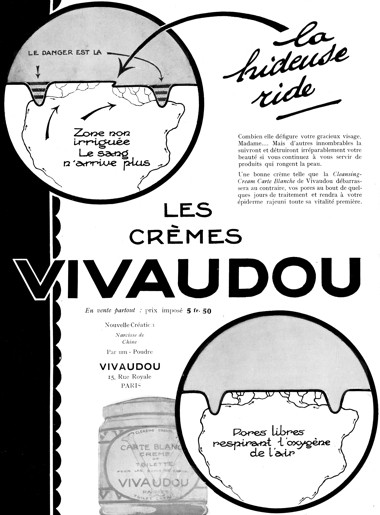
1924 Vivaudou Carte Blanche Cleansing-Cream. This advertisement suggests that blocked pores reduce oxygen uptake by the skin which results in ‘hideous wrinkles’ (France).
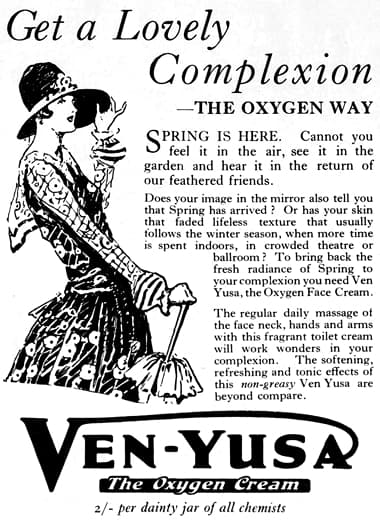
1926 Ven-Yusa oxygen cream (Australia).

1935 Helene Pessl Oxylation Treatment (Austria).
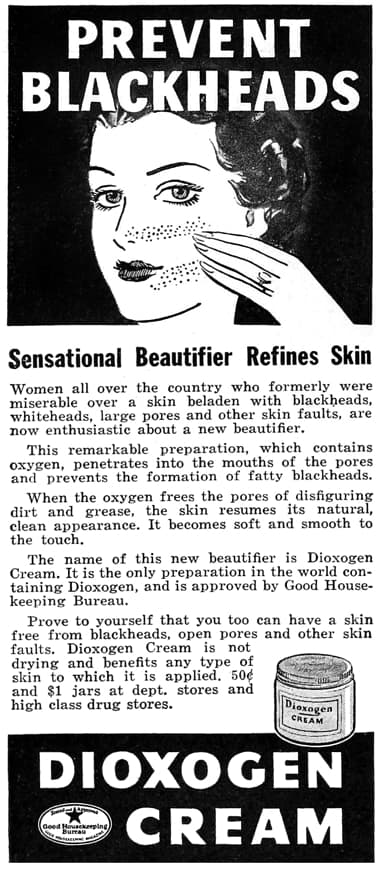
1937 Dioxogen Cream. It was originally sold as a disinfectant.
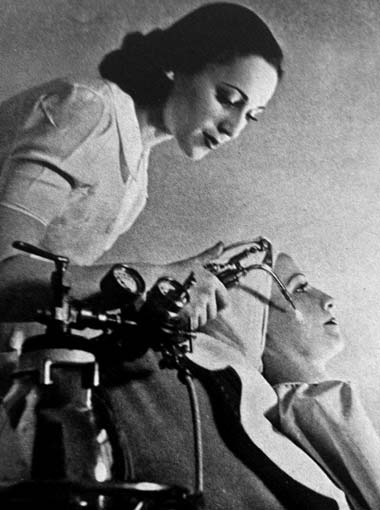
1938 Helena Rubinstein Oxylation Treatment. “To make your skin velvet-smooth, glow with life and radiance, have the vitalising new Oxylation Treatment just introduced by Madame Rubinstein. By a special process, live oxygen filtered through a gentle herbal vapour is sprayed on the skin, so that the pores can actually breathe it in. Under the oxygen’s influence, the skin is cleared of sallowness, dullness and every trace of discolouration. Leathery weatherbeaten skin becomes satin-soft, fair and younger looking.”

1939 Dermetics Cleansing Cream to avoid S.S. (‘suffocating skin’).
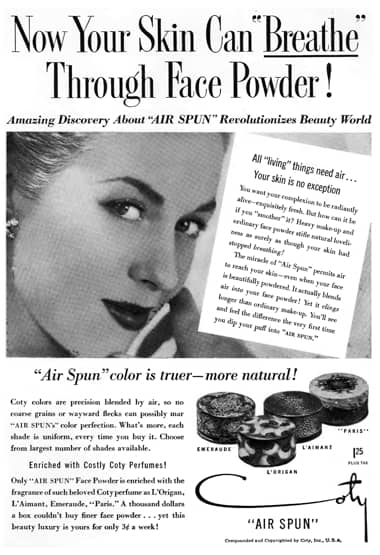
1951 Coty Air Spun Face Powder suggesting it allows the skin to ‘breathe’.

A modern version of the oxygen skin treatment with updated claims. “For this procedure we use medical cosmetic products containing vitamins A, C and E, aloe vera extract and oxygen activating liquid. Oxygen pressure has a massaging effect during the procedure which fastens collagen and elastin synthesis.”
